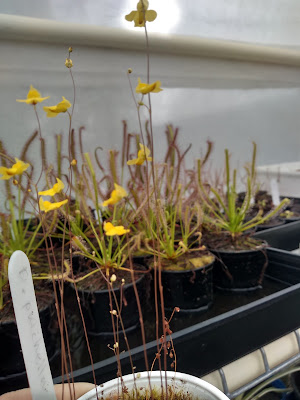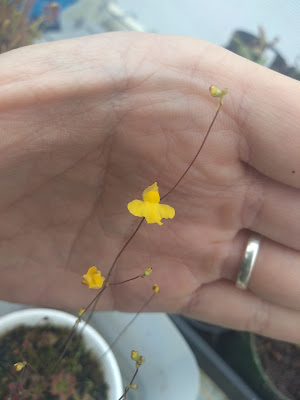A generous friend sent me some seeds of litchi tomato (Solanum sisymbriifolium) a while ago. I had never eaten, grown, or even seen this species before so this was something new to me.
Litchi tomato is also called Morelle de Balbis, vila-vila, sticky nightshade, red buffalo-bur, or fire-and-ice plant. My kids call these 'prickle tomatoes'.
 |
| Litchi tomatoes - can you see why my kids call them prickle tomatoes? |
Litchi tomatoes are somewhat related to tomatoes, tomatillos, and ground cherries. Like many of the vegetables we grow, they are a perennial that is treated as an annual.
I left my plants where they were over winter, fully expecting frosts to kill them. To my surprise they handled mild winter with frosts down to about -4C with minimal damage. I have no idea if they would survive a cold winter, but a mild winter didn't seem to bother them too much.
They flowered through winter but didn't set fruit in the cooker weather. I transplanted them in spring and with warmer weather they started fruiting pretty quick.
 |
| Litchi tomatoes flowering |
The leaves look deceptively soft and velvety, but have prickles on them. The stems and fruit husks also have prickles. The leaf shape varies a little from plant to plant, some have deeper divisions in the leaf while others are not as deep.
 |
| Litchi tomato leaf |
 |
| Leaves look soft, but have prickles |
I am told that they need more than one plant in order to set fruit. I don't have heaps of space to use so I plant several plants in the one hole. This ensures a pollinator is never far away.
I probably get less fruit per plant by having them this close, but it frees up space to grow other things so I am happy with the result.
 |
| I grow several plants in the same hole |
 |
| Litchi tomato stems are prickly |
Litchi tomatoes produce reasonably large, showy flowers that were white or bluish. They varied from plant to plant but were always rather ornamental and showy.
 |
| Litchi tomato flower |
 |
| Prickle tomato flowers |
 |
| Flowers vary slightly from plant to plant |
Fruit are born on a small truss with up to a dozen red fruits per truss. I found they took a while to flower, then the wait from flower to ripe fruit felt like it took some time, once they started to ripen they were nicely productive.
Fruit can be harvested once the husk starts to turn brown. Either individual fruits can be picked, or the entire truss can be snipped off and brought in.
I am told that ripe fruit slips out of the husk, but didn't experience that even once. I assume different strains act differently, and this one does not slip from the husk.
I was able to harvest carefully bare handed, but think using gloves would make harvest a lot faster and easier.
 |
| Litchi tomato truss |
Unlike many other fruits, I found that picking them when fully ripe made them taste bland. They were sweetest earlier, and got progressively less sweet and lost complexity of flavour the longer I left them.
Their taste varied from plant to plant, as well as varying as the fruit ripened. Some tasted a bit like cherry, some a bit fruity. Some tasted like kiwi fruit mixed with something nice, I liked those ones the best.
 |
| Ripe Litchi Tomatoes |
The fruit were glossy red on the outside, orange on the inside, and had a lot of small hard seeds in them.
I didn't mind the seeds at all as I didn't really notice them, but my wife disliked them and found them annoying.
 |
| Litchi tomato fruit with seeds |
I don't tend to grow many things with thorns and prickles. Unfortunately Litchi Tomatoes have a lot of prickles on pretty much all parts.
If you ever grow Litchi tomatoes be sure to stake or cage them to prevent them sprawling, and try not to grow them anywhere that you will be brushing past.
 |
| Litchi tomato - so thorny |
I am glad I got to grow these, and I am growing the overwintered plants again this summer. I really like the taste, plus the plants are intriguing and ornamental, so will likely grow them most years.
I don't have endless space, and there are a lot of things I want to grow, so going forward may have them on rotation and grow them every second year.
I do sell seeds of Litchi tomatoes, as well as a few other interesting edibles and perennial vegetables in Australia through my for sale page.


















































